Where does the name Jeep come from, and what does it have to do with Popeye?
Although the model was initially called MA and later MB, it soon began to be known throughout the world as Jeep
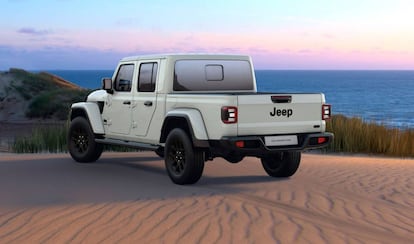
At the beginning of the summer of 1940, the General Staff of the United States Army summoned all car manufacturers in the country, urging them to develop a new vehicle to equip the armed forces. The plan was to substitute their old modified Model-T Fords with something that the military could use as a light transport and reconnaissance vehicle.
No less than 135 manufacturers answered the call, all vying to obtain the substantial contract despite a set of very demanding conditions: they had to manufacture 70 units of their prototype in a short period of time, in order to subject it to some very tough selection tests.
The army needed a light reconnaissance vehicle that, among other requirements, had to measure approximately 6 feet between its axles, to guarantee good maneuverability, and weight less than 1,300 pounds. It also had to have a 4×4 transmission to be able to operate on any type of terrain, and be mechanically very simple, to make disassembly and repair as easy as possible.
In the end, only three manufacturers managed to pass the ruthless selection process: Ford Motor Company, Willys-Overland Motors and American Bantam Car Manufacturing Company.
The Jeep in World War II
Initially, the winner of the contest was the last of the three companies, which at the time manufactured a popular microcar under the Bantam brand. However, after detecting some manufacturing defects, and due to its low production capacity, the contract ended up being awarded to Willys-Overland.
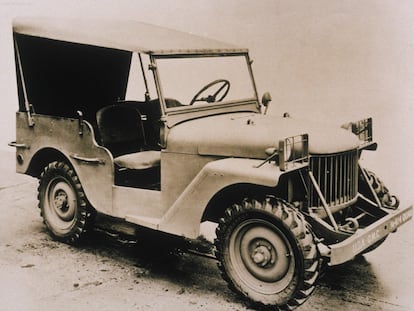
The company, which had been founded in 1908 by the American automobile pioneer John Willys, finished developing and perfecting the prototype requested by the Army and began to manufacture it. Then, in 1941, the production surged when Japan bombed Pearl Harbor and Germany declared war on the United States, forcing a gigantic deployment of troops on various distant battle fronts.
During the following years, the new military vehicle had a chance to prove its worth in decisive operations on European, African and Asian terrain, quickly becoming famous and highly appreciated, both among the troops and the civilians, who saw them in action on the news and in press photos that showed scenes of the great battles, such as the Allied landing in Normandy.
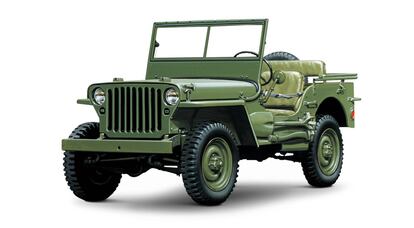
What does “Jeep” mean?
Although the model was initially called MA and later MB, it soon began to be known throughout the world as Jeep. The specific origin of this name remains uncertain, although the most accepted theory is that it comes from the initials of the term “general purpose,” the generic name used in military language to refer to this type of multipurpose reconnaissance vehicles.
However, another version suggests that the name comes from the nickname that the vehicle received during the exhaustive tests to which it was subjected, which, they say, was inspired by Eugene the Jeep, a character from the Popeye comics and cartoons. The strange creature that accompanied the famous sailor on his adventures was known for being able to sneak anywhere to successfully solve all problems; similar qualities to those exhibited by the agile and light all-terrain vehicle on the battlefield.
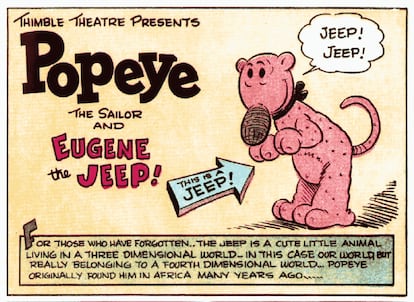
In 1945, after the war was over, Jeep production had reached 368,000 units. By 1950, since everyone knew the vehicle as Jeep, the brand decided to register the name. Seeing the success and the popularity it had gained as a military vehicle, the manufacturer also considered transforming it into a model for civilian use.
The Jeep leaves the Army
The result was an all-terrain car that at the time was unbeatable off the asphalt. This version was called CJ-2A; the first two letters indicated that it was indeed a civilian Jeep. The manufacturer kept this coded name until 1962, when another milestone in the history of the brand appeared: the Wagoneer. That car was different from everything that had come before, shaped like a station wagon with a four-wheel drive system and an automatic transmission to make it more comfortable to drive.
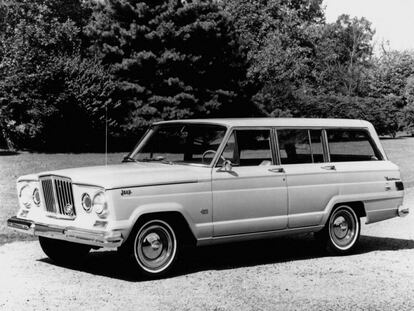
The model immediately achieved great sales success in the United States, and it is considered the ancestor of the SUVs that today dominate the market. It also overtook the British Range Rover by offering for the first time a luxury off-road vehicle that was equipped like a high-end sedan.
Throughout this evolution, the Jeep lost all trace of its military past. In 1984 another variant appeared: the Grand Wagoneer, which was larger and even better equipped. However, the brand did not completely abandon its roots, launching the famous Wrangler in 1986, a model that was just as effective off-road as the CJ, but more comfortable and suitable for daily use. Since then and throughout four different generations, its all-terrain spirit has remained unchanged.
Making its way to the present
Subsequent models continued to strengthen the sales and prestige of the brand, like the successful Cherokee from the 1980s and its successive generations, which in 1993 were joined by a larger version, the Grand Cherokee. Later, the Jeep range grew with various models of different sorts, such as the Compass and the Patriot in 2007, the Renegade in 2014 and the Gladiator pickup in 2018.
Throughout its history, the Jeep brand has changed owners numerous times. In 1970 the company was acquired by the American Motors Corporation (AMC), which did not keep it for long: five years later, it came under the management of Renault, for an equally brief period that ended in 1985 when Chrysler became the new owner until 1998, when it changed hands again, absorbed by the Daimler Group.
The large business structure that was formed then grew even more in 2014, when the creation of the new Italian-American group FCA brought together all the brands owned by Fiat and Chrysler, including Jeep; a great alliance whose growth continued in 2021 when the French group PSA joined to form Stellantis, a huge industrial merger that gave rise to the fourth most important company in the world. As part of this automotive giant, Jeep will release the new Avenger, the brand’s first electric SUV, at the end of the year.
Sign up for our weekly newsletter to get more English-language news coverage from EL PAÍS USA Edition
Tu suscripción se está usando en otro dispositivo
¿Quieres añadir otro usuario a tu suscripción?
Si continúas leyendo en este dispositivo, no se podrá leer en el otro.
FlechaTu suscripción se está usando en otro dispositivo y solo puedes acceder a EL PAÍS desde un dispositivo a la vez.
Si quieres compartir tu cuenta, cambia tu suscripción a la modalidad Premium, así podrás añadir otro usuario. Cada uno accederá con su propia cuenta de email, lo que os permitirá personalizar vuestra experiencia en EL PAÍS.
¿Tienes una suscripción de empresa? Accede aquí para contratar más cuentas.
En el caso de no saber quién está usando tu cuenta, te recomendamos cambiar tu contraseña aquí.
Si decides continuar compartiendo tu cuenta, este mensaje se mostrará en tu dispositivo y en el de la otra persona que está usando tu cuenta de forma indefinida, afectando a tu experiencia de lectura. Puedes consultar aquí los términos y condiciones de la suscripción digital.
More information
Últimas noticias
NASA discovers Titan doesn’t have an ocean, but a ‘slushy ice layer’ that increases possibility of life
Innocence lost in the forest of the child soldiers: ‘Each leader of the armed group had his girls’
‘Fallout’ or how the world’s largest company turned an anti-capitalist apocalyptic Western into a phenomenon
From inflation to defending migrants: Eileen Higgins and Zohran Mamdani inaugurate the new Democratic resistance against Trump
Most viewed
- ‘El Limones’ and the growing union disguise of Mexican organized crime
- Christian Louboutin: ‘Young people don’t want to be like their parents. And if their parents wear sneakers, they’re going to look for something else’
- The low-cost creative revolution: How technology is making art accessible to everyone
- ‘We are dying’: Cuba sinks into a health crisis amid medicine shortages and misdiagnosis
- A mountaineer, accused of manslaughter for the death of his partner during a climb: He silenced his phone and refused a helicopter rescue










































